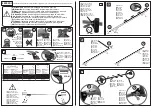
Operating Instructions
Van Walt Ltd | Prestwick Lane | Grayswood | Haslemere | Surrey | GU27 2DU | Tel. 01428 661 660 | Fax. 01428 656 808 | www.vanwalt.com
Rain Gauge
19
VAN WALT
Monitoring your needs
The datalogger produces incorrect measurements. The fault is in the sensor or the datalogger.
• Check the mechanical parts and the state of maintenance of the sensor, proceeding in
accordance with Chapter 7, “Maintenance”.
• Check the calibration of the sensor and, if necessary, recalibrate according to the relevant
instructions in Chapter 7, “Maintenance”.
• Check the Offset and Range settings of the datalogger and, if necessary, reset them.
The Offset and Range settings are part of the sensor calibration. Consult Chapter 7,
“Maintenance,” to correctly determine the values for Offset and Range.
The alarm of the sensor is not functioning or not functioning correctly.
• The alarm function is only supported by e-SENSE direct or the e-SENSE data site.
• If no alarm messages are received: check the settings for Alarm low, Hysteresis low, Hysteresis
high and Alarm high. Configure the alarm values if one or more settings are set on zero.
• If an alarm message is received once but not after that: the value for Hysteresis high should
be set lower than Alarm high, the value for Hysteresis low should be set higher than Alarm low.
If the problem persists, choose both hysteresis values in such a way that they approximate the
alarm values better.
• If many alarm messages are received repeatedly: choose the hysteresis values in such a
way that the difference with the alarm values is increased. If the problem persists, check the
course of the measurements and set a higher Sample speed if the measurements are widely
dispersed.
7.
Maintenance
Reliable and accurate measuring results can only be achieved with regular maintenance. We
recommend you inspect the rain gauge at set times and, if necessary, clean it or repair it in the
following areas:
•
Regularly inspect the water-collecting basin and the filter for dirt, damage or blockages. It
should be noted that during certain periods of the year, leaves, dust and dirt tend to collect
in the water-collecting basin and filter. Leaves can simply be removed, while the filter may be
cleaned after removing the cover and then the filter. Clean the filter and reassemble in reverse
order.
• Regularly inspect the tipping bucket for any dirt. Clean if necessary. When doing this, ensure
that the switch is not operated if the datalogger is turned on.
• If at certain times the datalogger is turned off, or if the rain gauge is temporarily out of use
for other reasons, take this opportunity to check the hinge point of the tipping bucket. If it is
possible to move the tipping bucket to the centre position without it getting off balance, the
hinge point must be cleaned thoroughly.
• Check the horizontal position of the instrument every time maintenance is carried out. Despite
the solid design of the field support, in practice the rain gauge can loose its balance as a result
of ground motion, vandalism or rough handling.





































